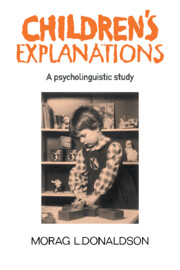Book contents
- Frontmatter
- Contents
- List of illustrations
- List of tables
- Acknowledgements
- 1 Introduction
- 2 The development of the causal connectives and of causality: some previous studies
- 3 Elicited production studies
- 4 The empirical mode
- 5 The intentional mode
- 6 The deductive mode
- 7 General discussion
- Appendices
- 1 Details of procedures for elicited production experiments
- 2 Sequences and items for Experiment 4
- 3 Stories and items used in Experiment 5
- 4 Materials used in Experiment 6 (Deductive/Empirical)
- 5 Acceptability judgement questionnaire based on Experiment 6
- 6 Materials used in Experiment 7 (Deductive Marking)
- Notes
- References
- Index
7 - General discussion
Published online by Cambridge University Press: 21 September 2009
- Frontmatter
- Contents
- List of illustrations
- List of tables
- Acknowledgements
- 1 Introduction
- 2 The development of the causal connectives and of causality: some previous studies
- 3 Elicited production studies
- 4 The empirical mode
- 5 The intentional mode
- 6 The deductive mode
- 7 General discussion
- Appendices
- 1 Details of procedures for elicited production experiments
- 2 Sequences and items for Experiment 4
- 3 Stories and items used in Experiment 5
- 4 Materials used in Experiment 6 (Deductive/Empirical)
- 5 Acceptability judgement questionnaire based on Experiment 6
- 6 Materials used in Experiment 7 (Deductive Marking)
- Notes
- References
- Index
Summary
Overview
The review of previous studies of the development of the causal connectives (see Chapter 2) revealed a discrepancy between the evidence from children's spontaneous speech, which indicates that children as young as 2½ years have an understanding of the directional element of the causal connectives' meaning, and the evidence from comprehension experiments, which suggests that such understanding is not present until the age of about 7 or 8 years. Two gaps in the existing literature were also identified. First, there was a lack of systematic studies of preschool children's production of the causal connectives in an experimental setting. Second, previous experiments had been based almost exclusively on the empirical mode. The present study aimed to reduce these two gaps in our knowledge and also to provide an explanation for the discrepancy between the spontaneous speech data and the data from comprehension experiments.
In Chapter 3, some elicited production studies were reported. These yielded data on the way 3- to 5-year-olds use the causal connectives when they are giving explanations of a range of phenomena in an experimental setting.
Chapter 4 reported an experiment which was based on the empirical mode and which was designed to test a hypothesis about the reason for the discrepancy between the two types of data: the causal direction hypothesis. This hypothesis states that children understand the directional element of the causal connectives' meaning in terms of causal direction before they understand that the causal connectives can also convey information about temporal order.
- Type
- Chapter
- Information
- Children's ExplanationsA Psycholinguistic Study, pp. 136 - 154Publisher: Cambridge University PressPrint publication year: 1986

